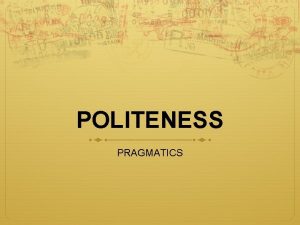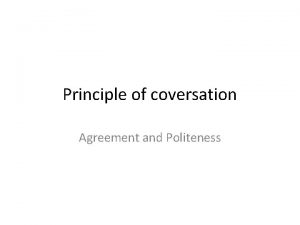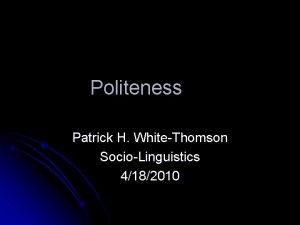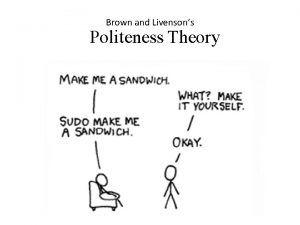POLITENESS PRINCIPLE Politeness Maxims Politeness Notions Two notions





![n Generosity Maxim (Bidal Kemurahhatian) Minimize benefit to self [maximize cost to self] You n Generosity Maxim (Bidal Kemurahhatian) Minimize benefit to self [maximize cost to self] You](https://slidetodoc.com/presentation_image_h/bcac56d967f7292dee1bdb4548826bbf/image-6.jpg)

- Slides: 7

POLITENESS PRINCIPLE: Politeness Maxims

Politeness Notions Two notions of politeness should be differentiated: n Common politeness Being polite means showing good manners and consideration for other people (e. g. open the door for a lady, give your seat to an elderly person in public transport) n Linguistics politeness The way people choose to speak and how the hearers react to their speech. Politeness is essentially asymmetrical: what is polite with respect to hearer or to some third party will be impolite with respect to speaker, and vice versa.

Politeness Scales The degree of politeness of an illocution can be measured by different scales: • Cost-benefit scale This indicates cost and/or benefit of proposition to hearer (benefit to hearer = greater politeness; cost to hearer = less politeness) • Indirectness scale This indicates degree of politeness on the basis of evaluating the same propositional content under increasingly indirect kinds of illocution (higher indirectness = greater politeness) • Optionality scale This indicates how far the performance of an illocution is at the act choice of hearer (higher optionality = greater politeness)

Lakoff’s Politeness Maxims Lakoff proposes three maxims of politeness: n Don’t impose ‘ I’m sorry to bother you but … ‘ n Give options ‘ Would you mind if … ‘ ‘ Could you possibly … ‘ ‘ Can I ask you to … ‘ n Make your receiver feel good ‘ You’re better at this than me … ‘

Leech’s Politeness Principle A very general formulation of Leech’s Politeness Principle is as follows: n Minimize (other things being equal) the expression of impolite beliefs. n Maximize (other things being equal) the expression of polite beliefs. Leech’s Politeness Principle is described as a set of maxims that speakers assume are following. • Tact Maxim (Bidal Ketimbangrasaan) Minimize cost to other [maximize benefit to other] Have another sandwich * Hand me the newspaper.
![n Generosity Maxim Bidal Kemurahhatian Minimize benefit to self maximize cost to self You n Generosity Maxim (Bidal Kemurahhatian) Minimize benefit to self [maximize cost to self] You](https://slidetodoc.com/presentation_image_h/bcac56d967f7292dee1bdb4548826bbf/image-6.jpg)
n Generosity Maxim (Bidal Kemurahhatian) Minimize benefit to self [maximize cost to self] You must come and have dinner with us. *We must come and have dinner with you. n Approbation Maxim (Bidal Keperkenaan) Minimize dispraise of other [maximize praise of other] Her performance was outstanding *Her performance was not so good as it might have been. n Modesty Maxim (Bidal Kerendahhatian) Minimize praise of self [maximize dispraise of self] How stupid of me! *How clever of me!

n Agreement Maxim (Bidal Kesetujuan) Minimize disagreement between self and other [maximize agreement between self and other] A : It is an interesting exhibition, wasn’t it? B : Yes, definitely. B : *No, it was very uninteresting. n Sympathy Maxim (Bidal Kesimpatian) Minimize antipathy between self and other [maximize sympathy between self and other] I’m terribly sorry to hear that your cat died. *I’m terribly pleased to hear that your cat died.












